Spatiotemporal Analysis of Influencing Factors of Carbon Emission in Public Buildings in China
Abstract
:1. Introduction
2. Literature Review
2.1. Spatiotemporal Analysis of Carbon Emission
2.2. Influencing Factors of Buildings Carbon Emission
2.3. Research Gap
3. Data Source and Methodologies
3.1. Study Area
3.2. Data Source
3.3. Methodology
3.3.1. Hot Spot Analysis
3.3.2. Geographically and Temporally Weighted Regression Model
3.3.3. Model Specification
3.3.4. Index Calculation
- Calculation methods of CO2 emission
- 2.
- Index of green building
- 3.
- Industrial Structure
4. Empirical Results
4.1. Spatial Distribution of Carbon Emission in Different Areas
4.2. Hot Spot Analysis of Carbon Emissions from Public Building Operations
4.3. Spatial Effects of the Influencing Factors of Public Buildings Carbon Emissions
- Spatial and temporal variation in the effect of population on carbon emissions
- 2.
- Spatial and temporal variation in the effect of urbanization on carbon emissions
- 3.
- Spatial and temporal variation in the effect of industrial structure on carbon emissions
- 4.
- Spatial and temporal variation in the effect of GDP per capita on carbon emissions
- 5.
- Spatial and temporal variation in the effect of the green building index on carbon emissions
5. Conclusions and Policy Suggestions
5.1. Conclusions
5.2. Suggestions
Author Contributions
Funding
Data Availability Statement
Conflicts of Interest
References
- Nässén, J.; Holmberg, J.; Wadeskog, A.; Nyman, M. Direct and indirect energy use and carbon emissions in the production phase of buildings: An input–output analysis. Energy 2007, 32, 1593–1602. [Google Scholar] [CrossRef]
- Zhu, W.; Feng, W.; Li, X.; Zhang, Z. Analysis of the embodied carbon dioxide in the building sector: A case of China. J. Clean. Prod. 2020, 269, 122438. [Google Scholar] [CrossRef]
- China Building Energy Consumption Annual Report 2020; China Association of Building Energy Efficiency: Beijing, China, 2020.
- Zhang, Y.; Yan, D.; Hu, S.; Guo, S. Modelling of energy consumption and carbon emission from the building construction sector in China, a process-based LCA approach. Energy Policy 2019, 134, 110949. [Google Scholar] [CrossRef]
- Xiao, H.; Wei, Q.; Wang, H. Marginal abatement cost and carbon reduction potential outlook of key energy efficiency technologies in China׳s building sector to 2030. Energy Policy 2014, 69, 92–105. [Google Scholar] [CrossRef]
- Wu, X.; Peng, B.; Lin, B. A dynamic life cycle carbon emission assessment on green and non-green buildings in China. Energy Build. 2017, 149, 272–281. [Google Scholar] [CrossRef]
- Chen, L.; Xu, L.; Cai, Y.; Yang, Z. Spatiotemporal patterns of industrial carbon emissions at the city level. Resour. Conserv. Recycl. 2021, 169, 105499. [Google Scholar] [CrossRef]
- Huang, J.; Chen, X.; Yu, K.; Cai, X. Effect of technological progress on carbon emissions: New evidence from a decomposition and spatiotemporal perspective in China. J. Environ. Manag. 2020, 274, 110953. [Google Scholar] [CrossRef]
- Cui, Y.; Khan, S.U.; Deng, Y.; Zhao, M. Regional difference decomposition and its spatiotemporal dynamic evolution of Chinese agricultural carbon emission: Considering carbon sink effect. Environ. Sci. Pollut. Res. 2021, 28, 38909–38928. [Google Scholar] [CrossRef]
- Wang, L.; Fan, J.; Wang, J.; Zhao, Y.; Li, Z.; Guo, R. Spatio-temporal characteristics of the relationship between carbon emissions and economic growth in China’s transportation industry. Environ. Sci. Pollut. Res. 2020, 27, 32962–32979. [Google Scholar] [CrossRef]
- Hu, M.; Li, R.; You, W.; Liu, Y.; Lee, C.-C. Spatiotemporal evolution of decoupling and driving forces of CO2 emissions on economic growth along the Belt and Road. J. Clean. Prod. 2020, 277, 123272. [Google Scholar] [CrossRef]
- Han, Y.; Jin, B.; Qi, X.; Zhou, H. Influential Factors and Spatiotemporal Characteristics of Carbon Intensity on Industrial Sectors in China. Int. J. Environ. Res. Public Health 2021, 18, 2914. [Google Scholar] [CrossRef] [PubMed]
- Falahatkar, S.; Rezaei, F. Towards low carbon cities: Spatio-temporal dynamics of urban form and carbon dioxide emissions. Remote Sens. Appl. Soc. Environ. 2020, 18, 100317. [Google Scholar] [CrossRef]
- Bai, J.; Qu, J. Investigating the spatiotemporal variability and driving factors of China’s building embodied carbon emissions. Environ. Sci. Pollut. Res. 2021, 18, 19186–19201. [Google Scholar] [CrossRef]
- Huang, L.; Krigsvoll, G.; Johansen, F.; Liu, Y.; Zhang, X. Carbon emission of global construction sector. Renew. Sustain. Energy Rev. 2018, 81, 1906–1916. [Google Scholar] [CrossRef] [Green Version]
- Lu, Y.; Cui, P.; Li, D. Carbon emissions and policies in China’s building and construction industry: Evidence from 1994 to 2012. Build. Environ. 2016, 95, 94–103. [Google Scholar] [CrossRef]
- Wu, Y.; Shen, L.; Zhang, Y.; Shuai, C.; Yan, H.; Lou, Y.; Ye, G. A new panel for analyzing the impact factors on carbon emission: A regional perspective in China. Ecol. Indic. 2019, 97, 260–268. [Google Scholar] [CrossRef]
- Mostafavi, F.; Tahsildoost, M.; Zomorodian, Z. Energy efficiency and carbon emission in high-rise buildings: A review (2005–2020). Build. Environ. 2021, 206, 108329. [Google Scholar] [CrossRef]
- Tan, X.; Lai, H.; Gu, B.; Zeng, Y. Carbon emission and abatement potential outlook in China’s building sector through 2050. Energy Policy 2018, 118, 429–439. [Google Scholar] [CrossRef]
- Wang, M.; Feng, C. Exploring the driving forces of energy-related CO2 emissions in China’s construction industry by utilizing production-theoretical decomposition analysis. J. Clean. Prod. 2018, 202, 710–719. [Google Scholar] [CrossRef]
- Huang, W.; Li, F.; Cui, S.-H.; Huang, L.; Lin, J.-Y. Carbon Footprint and Carbon Emission Reduction of Urban Buildings: A Case in Xiamen City, China. Procedia Eng. 2017, 198, 1007–1017. [Google Scholar] [CrossRef]
- Rose, T.D.E.A. Effects of population and affluence on CO2 emissions. Ecology 1997, 94, 175–179. [Google Scholar]
- Ma, M.; Shen, L.; Ren, H.; Cai, W.; Ma, Z. How to Measure Carbon Emission Reduction in China’s Public Building Sector: Retrospective Decomposition Analysis Based on STIRPAT Model in 2000–2015. Sustainability 2017, 9, 1744. [Google Scholar] [CrossRef] [Green Version]
- Ma, M.; Yan, R.; Cai, W. An extended STIRPAT model-based methodology for evaluating the driving forces affecting carbon emissions in existing public building sector: Evidence from China in 2000–2015. Nat. Hazards 2017, 89, 741–756. [Google Scholar] [CrossRef]
- Yang, X.; Jia, Z.; Yang, Z.; Yuan, X. The effects of technological factors on carbon emissions from various sectors in China—A spatial perspective. J. Clean. Prod. 2021, 301, 126949. [Google Scholar] [CrossRef]
- Dietz, T.; Rosa, E.A. Rethinking the Environmental Impacts of Population, Affluence and Technology. Hum. Ecol. Rev. 1994, 1, 277–300. [Google Scholar]
- York, R.; Rosa, E.A.; Dietz, T. STIRPAT, IPAT and ImPACT: Analytic tools for unpacking the driving forces of environmental impacts. Ecol. Econ. 2003, 46, 351–365. [Google Scholar] [CrossRef]
- Yan, H.; Liu, H.; Qiu, R.; Zhang, Y. Influencing Factors Analysis of Construction Industry Carbon Emissions Based on Stepwise Regression. J. Eng. Manag. 2021, 35, 16–21. [Google Scholar]
- Zhang, S.; Wang, K.; Yang, X.; Xu, W. Research on Emission Goal of Carbon Peak and Carbon Neutral in Building Sector. Build. Sci. 2021, 37, 189–198. [Google Scholar]
- Xie, J. Discussion on Peak Carbon Emissions and Energy Saving-Emission Reduction of Public Buildings in Chongqing Based on LEAP Model; Chongqing University: Chongqing, China, 2019; p. 103. [Google Scholar]
- Jiang, X. Study on Forecast and Factor Decomposition of Carbon Emissions about Chinese Large-Scale Public Buildings; Ocean University of China: Chongqing, China, 2012; p. 74. [Google Scholar]
- Xiao, H.; Yi, D. Empirical Study of Carbon Emissions Drivers Based on Geographically Time Weighted Regression. Model. Stat. Inf. Forum. 2014, 29, 83–89. [Google Scholar]
- Yang, D.; Liu, B.; Ma, W.; Guo, Q.; Li, F.; Yang, D. Sectoral energy-carbon nexus and low-carbon policy alternatives: A case study of Ningbo, China. J. Clean. Prod. 2017, 156, 480–490. [Google Scholar] [CrossRef]
- Lin, F.J.Z. Spatiotemporal distribution and provincial contribution decomposition of carbon emissions for the construction industry in China. Resour. Sci. 2019, 41, 897–907. [Google Scholar]
- Cheng, Z.; Li, L.; Liu, J. Industrial Structure, Technical Progress and Carbon Intensity in China’s Provinces. Renew. Sustain. Energy Rev. 2018, 81, 2935–2946. [Google Scholar] [CrossRef]
- Wang, H.; Zhang, B.; Liu, Y.; Liu, Y.; Xu, S.; Deng, Y.; Zhao, Y.; Chen, Y.; Hong, S. Muti-dimensional analysis of urban expansion patterns and their driving forces based on the center of gravity-GTWR model: A case study of the Beijing-Tianjin-Hebei urban agglomeration. Acta Geogr. Sin. 2018, 73, 1076–1092. [Google Scholar]
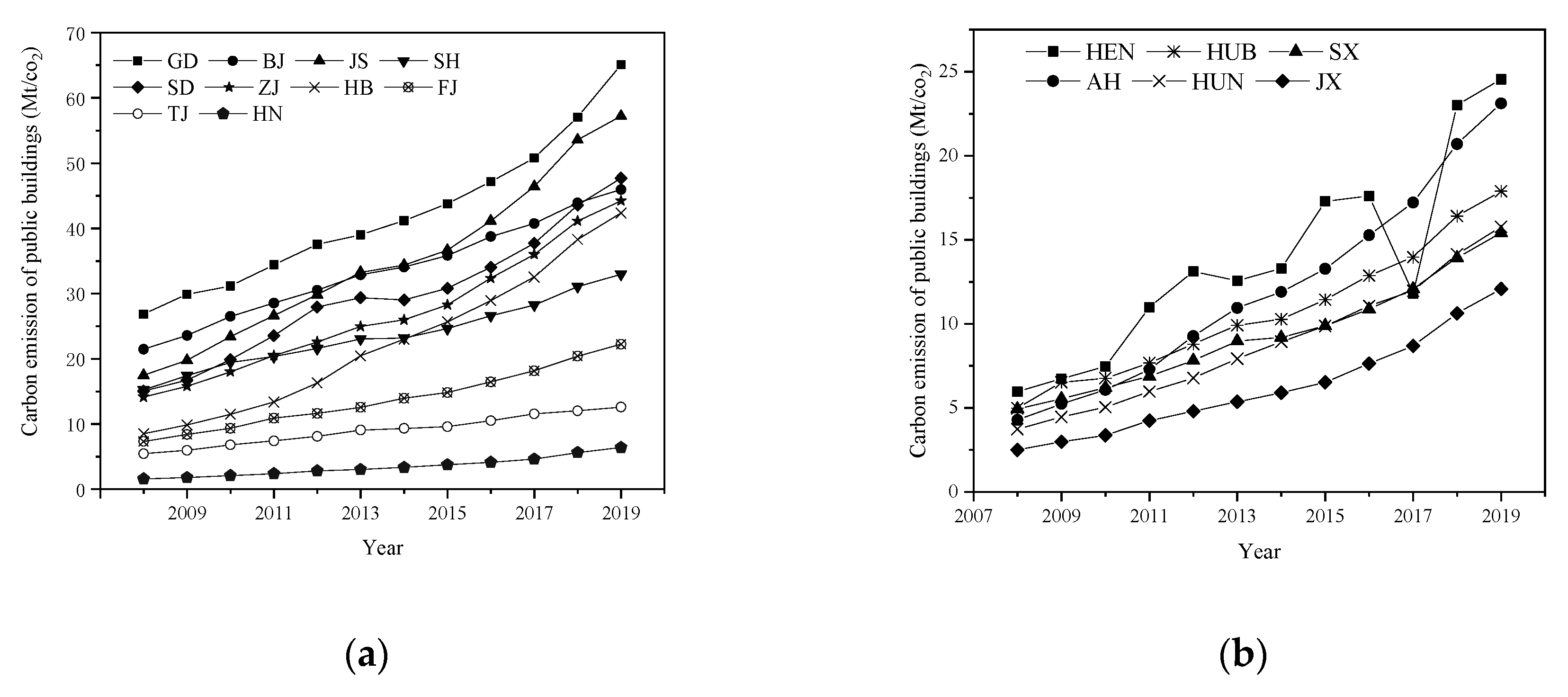
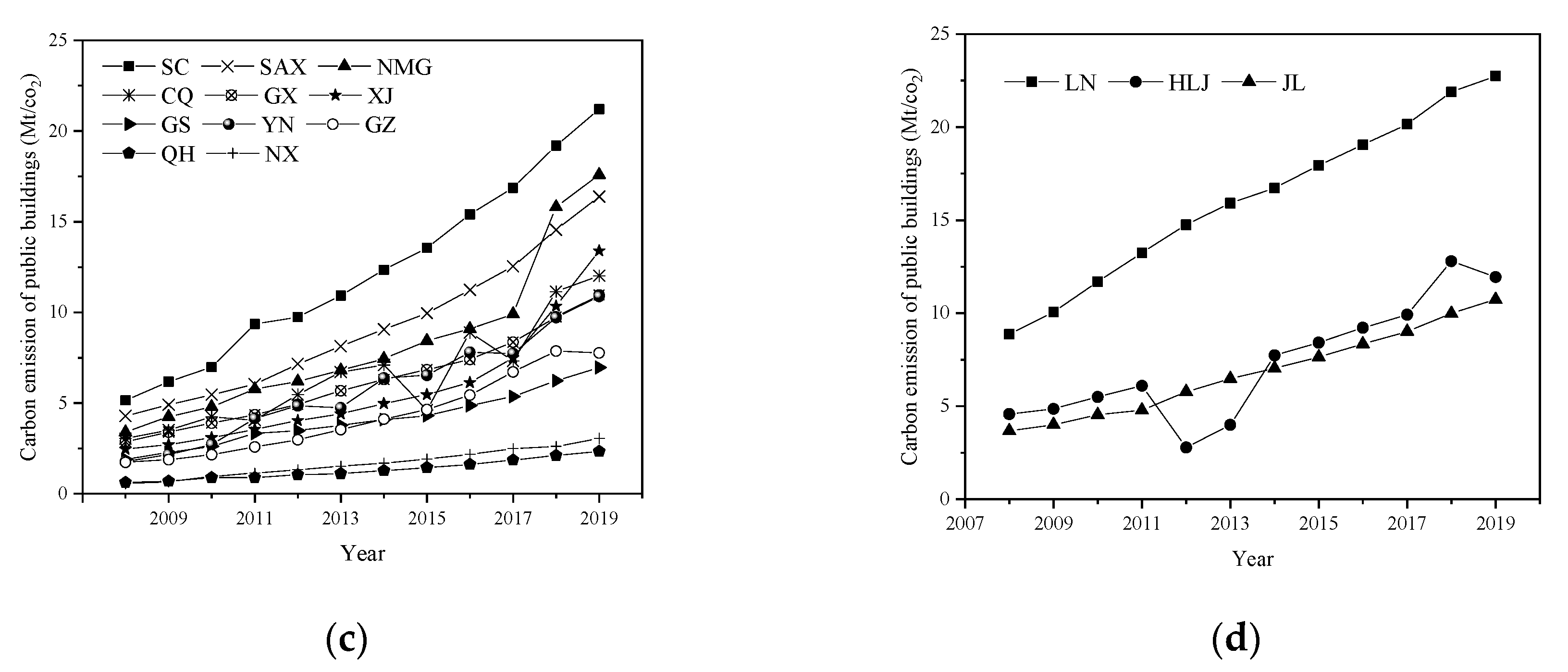

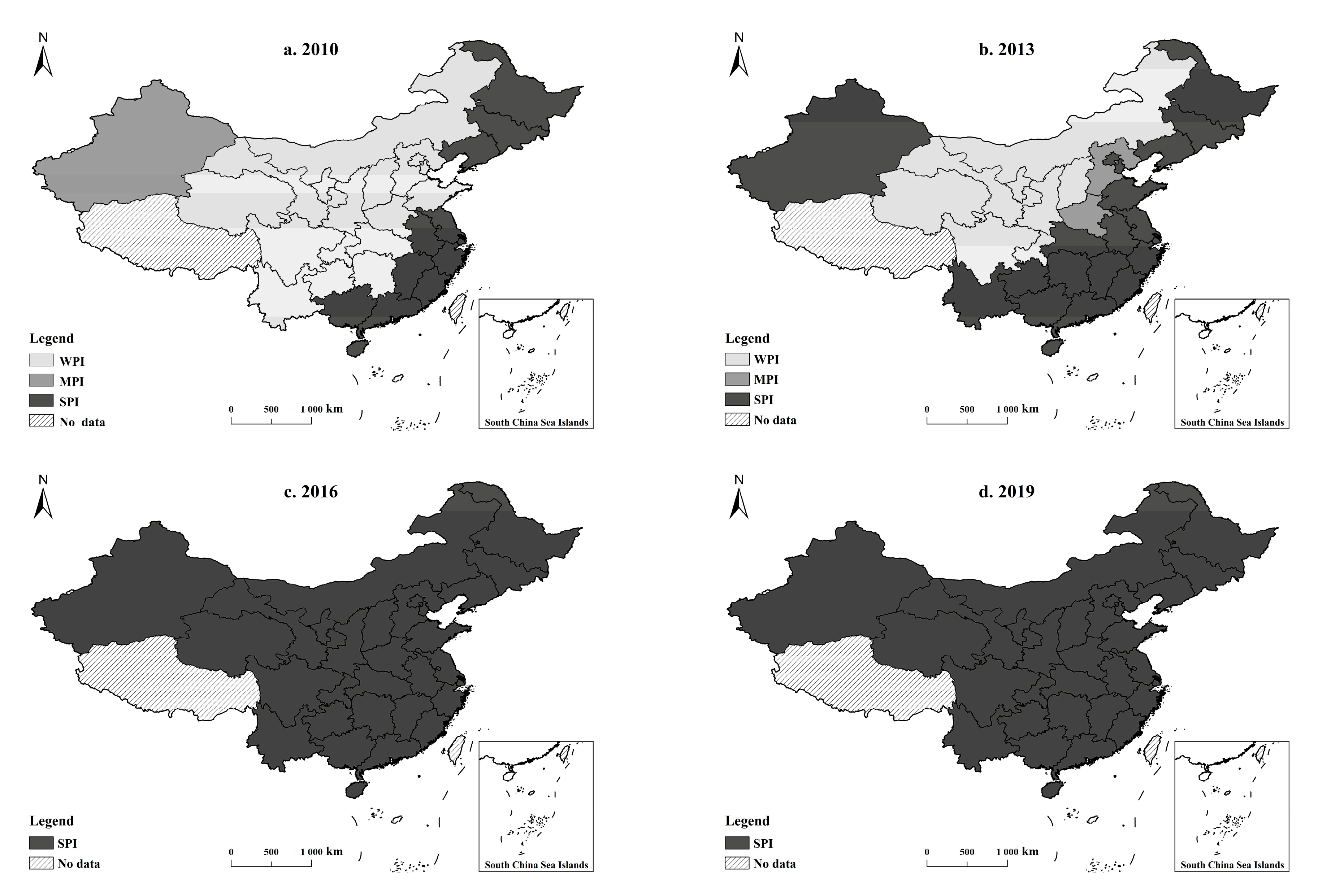

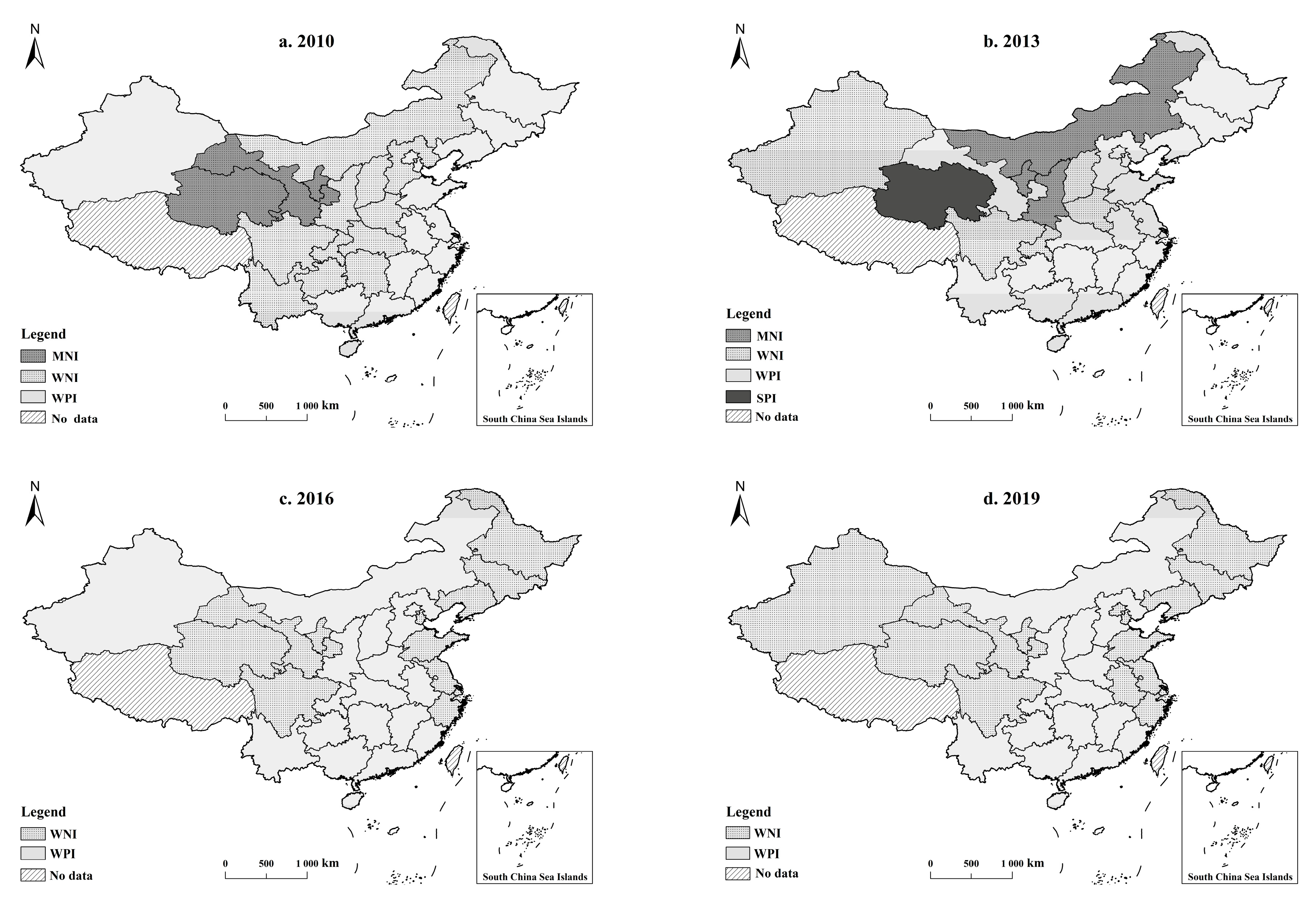
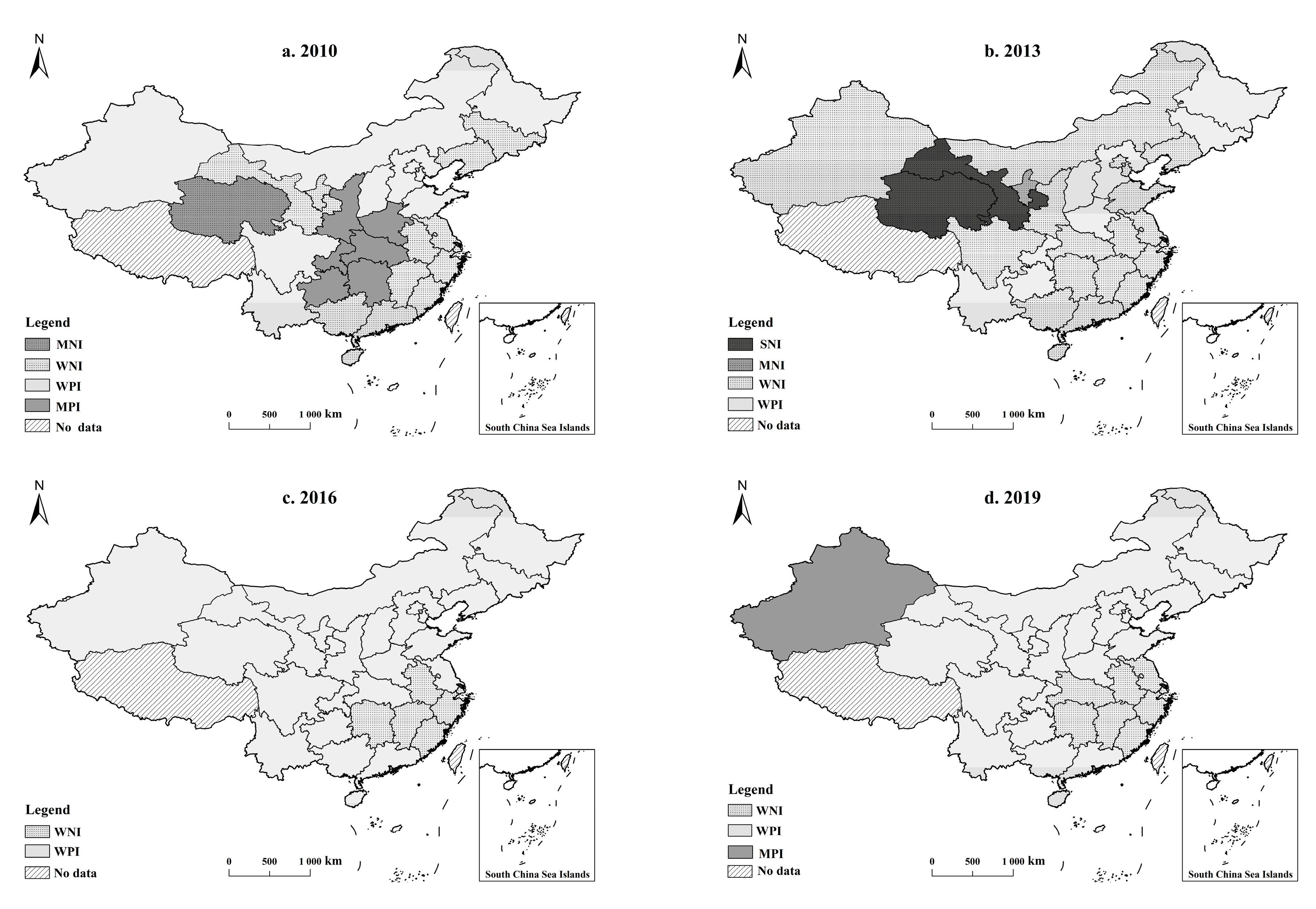
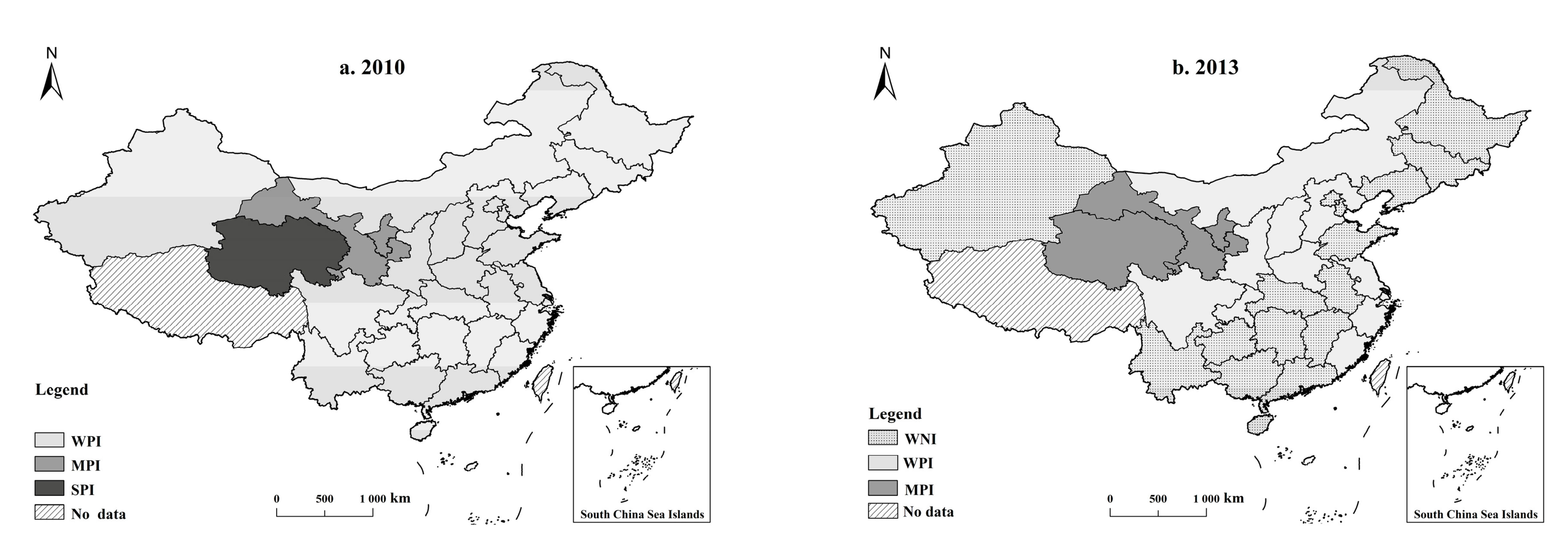
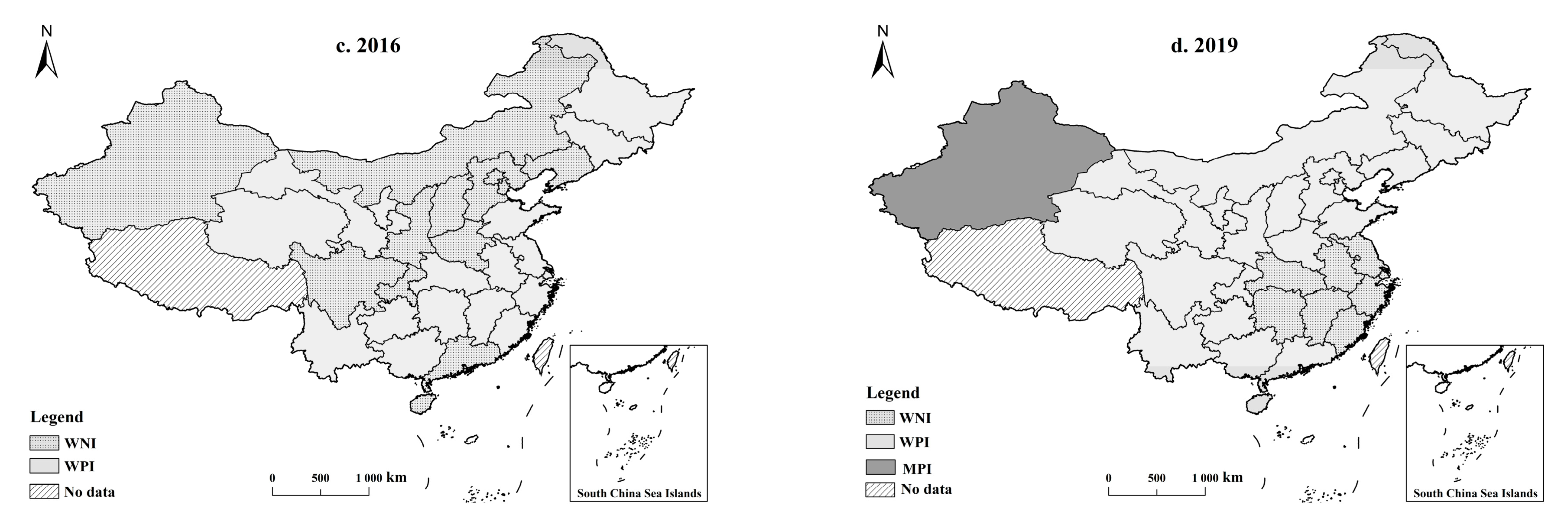
| Regions | Provincial District |
|---|---|
| East region | Beijing, Tianjin, Hebei, Shanghai, Jiangsu, Zhejiang, Fujian, Shandong, Guangdong, Hainan |
| Central region | Shanxi, Anhui, Jiangxi, Henan, Hubei, Hunan |
| West region | Inner Mongolia, Guangxi, Chongqing, Sichuan, Guizhou, Yunnan, Shaanxi, Gansu, Qinghai, Ningxia, Xinjiang |
| Northeast region | Liaoning, Jilin, Heilongjiang |
| Nomenclature | Variable | Unit | Type | Supporting References |
|---|---|---|---|---|
| C | Carbon emission of public buildings | tCO2 | dependent variable | |
| P | Population | Ten thousand people | explained variable | [28] |
| U | Urbanization level | % | explained variable | [24,29,30] |
| IS | Industrial structure | 1 | explained variable | [24,30,31] |
| G | GDP per capita | Yuan | explained variable | [32] |
| IGB | Index of green buildings | explained variable |
| Chinese Region Terminal Energy Category in Statistics Yearbook | Chinese Region Terminal Energy Category in Statistics Yearbook |
|---|---|
| Wholesale, retail trade and hotel, restaurants, and others | Coal, electricity, heat, liquefied petroleum gas, natural gas |
| Regional Grid | Coverage of Provinces and Cities | 2011 | 2012 | Average Value |
|---|---|---|---|---|
| North China Regional Grid | Beijing, Tianjin, Heibei, Shanxi, Shandong, Western Inner Mongolia | 0.8967 | 0.8843 | 0.8905 |
| East China Regional Grid | Liaoning, Jilin, Heilongjiang, Eastern Inner Mongolia | 0.8189 | 0.7769 | 0.7979 |
| Northeast Regional Grid | Shanghai, Jiangsu, Zhejiang, Anhui, Fujian | 0.7129 | 0.7035 | 0.7082 |
| Central China Regional Grid | Henan, Hubei, Hunan, Jiangxi, Sichuan, Chongqing | 0.5955 | 0.5257 | 0.5606 |
| Northwest Regional Grid | Shaanxi, Gansu, Qinghai, Ningxia, Xinjiang | 0.6860 | 0.6671 | 0.67655 |
| Southern Regional Grid | Guangdong, Guangxi, Yunnan, Guizhou, Hainan | 0.5748 | 0.5271 | 0.55095 |
| Provinces and Cities | Thermal CO2 Emission Coefficient | Provinces and Cities | Thermal CO2 Emission Coefficient | Provinces and Cities | Thermal CO2 Emission Coefficient | Provinces and Cities | Thermal CO2 Emission Coefficient |
|---|---|---|---|---|---|---|---|
| Anhui | 116 | Guizhou | 292 | Hunan | 110 | Sichuan | 105 |
| Beijing | 88 | Hainan | 57 | Jilin | 132 | Tianjin | 108 |
| Fujian | 112 | Hebei | 122 | Jiangsu | 109 | Xinjiang | 109 |
| Gansu | 110 | Henan | 124 | Jiangxi | 134 | Yunnan | 149 |
| Guangdong | 93 | Heilongjiang | 155 | Liaoning | 130 | Zhejiang | 104 |
| Guangxi | 153 | Hubei | 122 | Inner Mongolia | 160 | Chongqing | 98 |
| Ningxia | 120 | Qinghai | 245 | Shandong | 114 | Shanxi | 116 |
| Shaanxi | 149 |
Publisher’s Note: MDPI stays neutral with regard to jurisdictional claims in published maps and institutional affiliations. |
© 2022 by the authors. Licensee MDPI, Basel, Switzerland. This article is an open access article distributed under the terms and conditions of the Creative Commons Attribution (CC BY) license (https://creativecommons.org/licenses/by/4.0/).
Share and Cite
Du, Z.; Liu, Y.; Zhang, Z. Spatiotemporal Analysis of Influencing Factors of Carbon Emission in Public Buildings in China. Buildings 2022, 12, 424. https://doi.org/10.3390/buildings12040424
Du Z, Liu Y, Zhang Z. Spatiotemporal Analysis of Influencing Factors of Carbon Emission in Public Buildings in China. Buildings. 2022; 12(4):424. https://doi.org/10.3390/buildings12040424
Chicago/Turabian StyleDu, Zhuoqun, Yisheng Liu, and Zhidong Zhang. 2022. "Spatiotemporal Analysis of Influencing Factors of Carbon Emission in Public Buildings in China" Buildings 12, no. 4: 424. https://doi.org/10.3390/buildings12040424
APA StyleDu, Z., Liu, Y., & Zhang, Z. (2022). Spatiotemporal Analysis of Influencing Factors of Carbon Emission in Public Buildings in China. Buildings, 12(4), 424. https://doi.org/10.3390/buildings12040424






